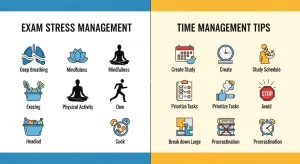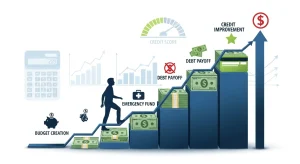Building wealth for retirement planning requires a strategic approach to investing that balances growth potential with risk management. Whether you’re just starting your career or approaching retirement age, understanding the fundamentals of investment strategies and retirement accounts can significantly impact your financial security and lifestyle in your golden years.
The landscape of retirement savings has evolved dramatically, with traditional pensions largely replaced by employer-sponsored 401k plans and individual IRA accounts. This shift places greater responsibility on individuals to make informed decisions about their financial future, making comprehensive knowledge of investing principles more crucial than ever before.
Essential Budgeting & Saving Strategies
Understanding the Fundamentals of Retirement Planning
Effective retirement planning begins with determining how much income you’ll need to maintain your desired lifestyle after leaving the workforce. Financial experts typically recommend replacing 70% to 90% of your annual pre-retirement income through savings and Social Security, though individual needs vary based on health care costs, travel plans, and housing decisions.
The power of compound growth makes early investing incredibly valuable for retirement savings. Even modest contributions to retirement accounts in your twenties can grow to substantial amounts by retirement age, thanks to decades of compound returns. This mathematical reality underscores why starting early is one of the most important investment strategies for long-term wealth building.
Key Retirement Account Options
Traditional and Roth IRAs offer individual control over retirement savings with different tax advantages. Traditional IRAs allow contributions up to $7,000 for those under 50 and $8,000 for those over 50 in 2025, with tax-deferred growth until withdrawal. Roth IRAs use after-tax dollars but provide tax-free withdrawals in retirement.
401k plans remain the cornerstone of employer-sponsored retirement benefits, allowing employees to contribute pre-tax income while often receiving employer matching contributions. 401k plans offer greater contribution flexibility than IRA plans and may include participant loans and hardship withdrawals for added flexibility.
SEP and SIMPLE IRAs serve small business owners and self-employed individuals, providing higher contribution limits than traditional IRAs while maintaining relatively simple administration requirements.
Sleep Improvement & Relaxation: Your Complete Guide to Better Rest
Essential Investment Strategies for Long-term Growth
Successful investing for retirement requires a diversified approach that evolves with your age and risk tolerance. The traditional rule of subtracting your age from 100 to determine stock allocation (e.g., a 30-year-old might hold 70% stocks) provides a starting framework, though individual circumstances should guide final decisions.
Asset allocation forms the foundation of effective portfolio management. A well-diversified portfolio typically includes domestic and international stocks, bonds, and potentially alternative investments like real estate investment trusts (REITs). This diversification helps reduce risk while capturing growth opportunities across different economic conditions.
Dollar-cost averaging through regular contributions to retirement accounts helps smooth market volatility over time. By investing fixed amounts consistently, you automatically buy more shares when prices are low and fewer when prices are high, potentially improving long-term returns.
Building Your Investment Portfolio
Index funds and ETFs offer low-cost exposure to broad market segments, making them excellent core holdings for retirement portfolios. These passive investments track market indices like the S&P 500, providing instant diversification with minimal fees that can significantly impact long-term returns.
Target-date funds automatically adjust asset allocation based on your expected retirement date, becoming more conservative as you approach retirement. While convenient, these funds may not perfectly match individual risk tolerance or retirement timeline preferences.
Individual stock selection requires more research and monitoring but can potentially generate higher returns for knowledgeable investors. However, the time commitment and additional risk make broad market exposure through index funds more suitable for most retirement savers.
Gut Health and Probiotics Explained
Maximizing Employer Benefits and Tax Advantages
401k employer matching represents free money that significantly accelerates retirement savings growth. Always contribute enough to capture the full employer match before considering other investment options. A typical 50% match on 6% of salary effectively provides an immediate 50% return on your contribution.
Tax-loss harvesting in taxable investment accounts can reduce current tax liability while maintaining desired asset allocation. This strategy involves selling investments at a loss to offset capital gains, then purchasing similar but not identical investments to maintain market exposure.
Roth IRA conversions allow you to move money from traditional retirement accounts to Roth accounts, paying taxes now in exchange for tax-free future growth. This strategy works best when current tax rates are lower than expected future rates or when you want to reduce required minimum distributions in retirement.
Mindfulness & Mental Health: The Complete Guide to Inner Peace
Age-Specific Investment Strategies
Early career investing (20s-30s) should emphasize growth through higher stock allocations, aggressive savings rates, and maximum utilization of tax-advantaged accounts. The long time horizon allows for recovery from market downturns while maximizing compound growth potential.
Mid-career optimization (40s-50s) requires balancing continued growth with increasing stability. This phase often involves peak earning years, making it crucial to maximize retirement contributions while beginning to reduce portfolio risk gradually.
Pre-retirement preparation (50s-60s) focuses on wealth preservation and income planning. Asset allocation typically shifts toward more conservative investments, while strategies like catch-up contributions help accelerate final accumulation years.
Managing Investment Risk
Diversification across asset classes, geographic regions, and investment styles helps reduce portfolio volatility without necessarily sacrificing returns. Modern portfolio theory demonstrates that combining non-correlated assets can improve risk-adjusted returns over time.
Regular portfolio rebalancing maintains target asset allocation as different investments perform differently. This disciplined approach forces you to sell high-performing assets and buy underperforming ones, potentially enhancing long-term returns.
Emergency fund maintenance prevents the need to tap retirement accounts during financial hardships. Maintaining 3-6 months of expenses in easily accessible accounts protects long-term investment strategies from short-term cash flow needs.
Mastering Virtual Interviews: Tech and Etiquette Tips
Advanced Retirement Planning Strategies
Health Savings Accounts (HSAs) offer triple tax advantages for those with high-deductible health plans: deductible contributions, tax-free growth, and tax-free withdrawals for qualified medical expenses. After age 65, HSAs can be used for any purpose with only ordinary income tax on withdrawals.
Social Security optimization involves timing benefit claims to maximize lifetime payments. Delaying benefits beyond full retirement age increases monthly payments by approximately 8% per year until age 70, significantly impacting total lifetime benefits.
Estate planning integration ensures retirement assets transfer efficiently to heirs while minimizing tax implications. Strategies like beneficiary designations, trusts, and charitable giving can significantly impact net wealth transfer.
Simple Office Desk Stretches to Stay Active at Work
Common Retirement Planning Mistakes to Avoid
Many investors underestimate the impact of fees on long-term returns. A seemingly small 1% annual fee difference can reduce retirement wealth by hundreds of thousands of dollars over a 30-year career. Prioritize low-cost investment options whenever possible.
Market timing attempts often result in poor investment outcomes. Studies consistently show that investors who try to time market movements typically underperform those who maintain consistent investment schedules regardless of market conditions.
Inadequate diversification concentrates risk unnecessarily. This includes holding too much company stock in retirement plans or failing to diversify across asset classes, geographic regions, and investment styles.
FAQ: Investing & Retirement Planning
How much should I contribute to my 401k vs IRA?
First, contribute enough to your 401k to capture the full employer match. Then consider maxing out an IRA for additional investment options and potentially lower fees. If you can save more, return to maximizing your 401k contribution. The total depends on your income, tax situation, and retirement planning goals.
What’s the best investment strategy for retirement?
The best investment strategies for retirement planning depend on your age, risk tolerance, and timeline. Generally, younger investors should emphasize growth through stock-heavy portfolios, while those closer to retirement should gradually shift toward more conservative allocations. Diversification and consistent contributions matter more than perfect timing.
When should I start taking Social Security benefits?
Social Security timing significantly impacts your retirement planning. While you can claim as early as 62, benefits increase by approximately 8% per year if you delay beyond full retirement age until 70. Consider your health, other income sources, and life expectancy when making this crucial decision.
How do I manage investment risk as I approach retirement?
As retirement approaches, gradually shift your portfolio management toward more conservative investments. Reduce stock allocation, increase bond holdings, and consider strategies like bond ladders for predictable income. However, don’t eliminate growth investments entirely, as you may need returns to outpace inflation for 20-30 years in retirement.
Quick Home Workout Routines for Busy Professionals
Start Building Your Retirement Wealth Today
Successful investing and retirement planning require consistent action over time rather than perfect timing or complex strategies. The most important step is starting now, regardless of your age or current savings level. Every dollar invested today has the potential to grow significantly by retirement through the power of compound returns.
Remember that retirement savings is a marathon, not a sprint. Focus on sustainable contribution rates, appropriate risk levels for your timeline, and low-cost investment options. Regular reviews and adjustments ensure your strategy remains aligned with your evolving goals and circumstances.
The combination of employer-sponsored 401k plans, individual IRA accounts, and taxable investment accounts provides multiple tools for building retirement wealth. Take advantage of all available tax-advantaged options while maintaining appropriate diversification and risk management.
Your future self will thank you for the investment decisions you make today. Start with what you can afford, increase contributions as your income grows, and stay committed to your long-term retirement planning goals.
Recommended Amazon Products for Retirement Planning:
“The Bogleheads’ Guide to Retirement Planning” – Comprehensive retirement strategy book
Financial Calculator for Retirement Planning – Advanced calculations made simple
“A Random Walk Down Wall Street” – Investment strategy classic
Retirement Planning Workbook – Step-by-step planning guide
“The Simple Path to Wealth” – Index fund investing approach
Portfolio Tracker & Investment Journal – Monitor your investments
“Your Money or Your Life” – Financial independence strategies











